The Colossi of Memnon, towering statues of Pharaoh Amenhotep III, are enduring symbols of ancient Egypt’s grandeur. Carved over 3,000 years ago, they once guarded a grand mortuary temple. Despite earthquakes and natural damage, the statues' mystery, including the singing phenomenon, continues to fascinate visitors. A blend of Egyptian, Greek, and Roman influences, the statues remain a testament to ancient craftsmanship. Today, they are a significant tourist attraction, providing insight into Egypt's religion, art, and architecture.

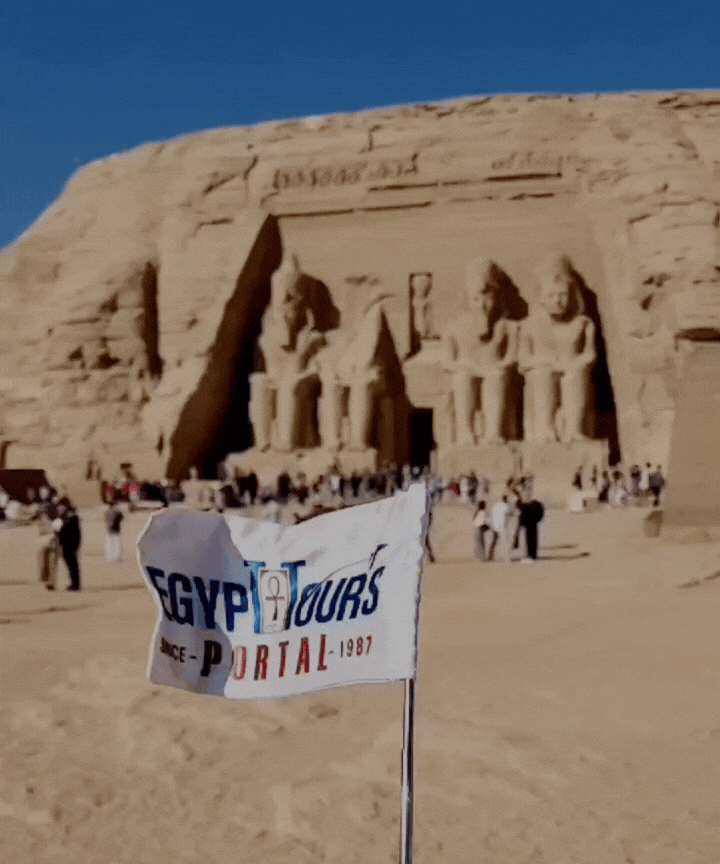
The Colossi of Memnon emerge from the shadows on the west bank of the Nile river in Thebes, standing as silent guardians of Egypt's ancient past. These towering statues of Pharaoh Amenhotep III, carved over 3,000 years ago, rise 60 feet into the sky, their faces aglow as the sun reveals their timeless expressions.
It was carved from single blocks of quartzite sandstone; they once stood at the gates of a grand temple that has now vanished, which once rivaled even the Temple of Karnak in magnificence. According to legend, after an earthquake cracked the northern statue in 27 BCE, it began to "sing" at dawn, drawing ancient travelers who believed it offered divine prophecies.
Though silent now, the Colossi remain symbols of resilience and mystery, embodying the enduring spirit of Egypt's past. Standing before them feels like stepping back into a time when gods and mortals walked together, a testament to a civilization whose legacy still captivates the world.

The Colossi of Memnon, two monumental stone statues depicting Pharaoh Amenhotep III (1386-1353 BCE), represent one of the most significant surviving artifacts from ancient Egypt’s 18th Dynasty. Crafted during the New Kingdom period, these statues are unique in their portrayal of Amenhotep III, seated regally on a throne.
Their construction dates back to approximately 1350 BCE, with each statue rising an impressive 18 meters (60 feet) high and weighing about 720 tons. The statues were carved from single blocks of quartzite stone, sourced from el-Gabal el-Ahmar near modern-day Cairo, a remarkable feat given the limited technology available. Transporting the massive stones southward to Luxor required moving them approximately 675 kilometers (420 miles), likely via intricate land and water routes, a testament to the ancient Egyptians’ advanced engineering skills.
Originally, the Colossi were built as sentinel statues guarding the entrance of Amenhotep III’s mortuary complex, one of the largest and most lavish temple structures ever constructed in Egypt, dedicated to the king’s deified spirit. In its time, this complex was likely unrivaled in grandeur and scale, even outshining the renowned Temple of Karnak.
However, the complex was largely destroyed over the centuries by natural forces such as annual Nile floods, earthquakes, and the historical practice of repurposing stone from older monuments to build new ones. These factors have left the Colossi as the only substantial remains of the once-thriving mortuary complex, where Amenhotep III was worshipped both as a living deity and posthumously. The statues’ endurance amid centuries of destruction highlights their role as resilient symbols of Amenhotep III’s lasting legacy.
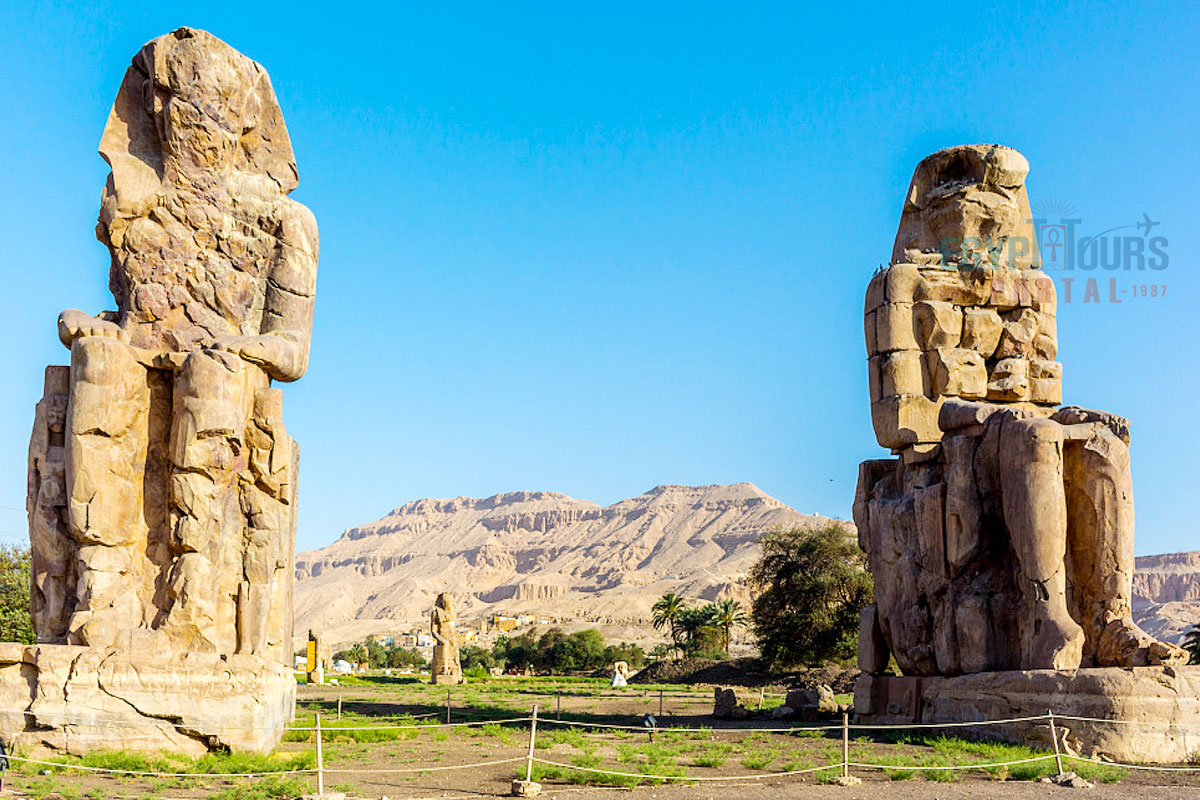
The Colossi are situated on the west bank of the Nile in the Theban Necropolis, just across the river from Luxor, and are part of one of Egypt's most significant ancient burial grounds. This location was historically chosen for its proximity to the Valley of the Kings and other royal burial sites, reflecting the ancient Egyptians’ emphasis on connecting with the afterlife.
Today, the Colossi of Memnon stand as central figures among Luxor’s cultural landmarks and are an essential part of any tour exploring the area. Located along the main road leading to the vast monuments of the west bank, they are approximately half a kilometer east of the Antiquities Inspectorate, which serves as the entrance for visitors.
As the first monumental structures that travelers see upon entering the site, the statues provide an awe-inspiring introduction to the ancient wonders awaiting exploration in Luxor’s Necropolis.
Discover the extraordinary attractions of the ancient golden city of Luxor
Read More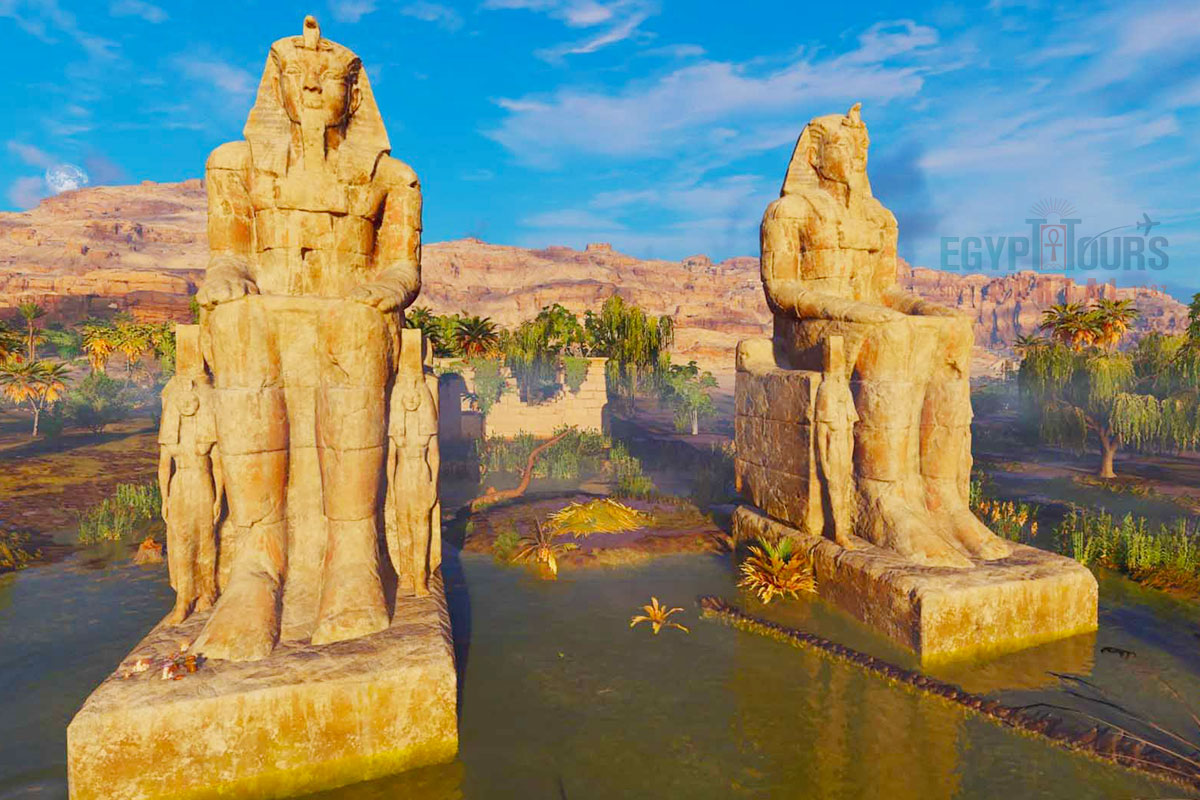
The name "Memnon" originates from Greek mythology and was assigned to these statues by ancient Greek travelers who misidentified them. Memnon, according to Greek lore, was a legendary Ethiopian king and the son of the goddess of dawn, Eos. He was renowned for his bravery and martial skill, ultimately joining the Trojan War to defend Troy against the Greeks, where he fell in battle to the hero Achilles.
The Greeks, impressed by the grandeur and scale of the Colossi, associated the statues with their fallen hero, Memnon, whom they believed embodied qualities of strength and resilience. Egyptian sources, however, did not connect the statues with Memnon but instead celebrated Amenhotep III, whom they regarded as a god-king.
Over time, the entire Theban Necropolis, including the mortuary complex, became known as the “Memnonium” in Greek accounts, a name that would persist for centuries. This association gave the statues an additional layer of mythical significance, connecting Amenhotep III’s legacy with the heroism of a foreign legend, which has added to their enduring allure.

Each of the statues reaches 18 meters (60 feet) in height and is crafted from a single quartzite sandstone block. Their design presents Amenhotep III seated majestically on a throne adorned with symbolic carvings and engravings of hieroglyphs that reflect both his royal status and divine associations.
The statues depict the king with his hands resting on his knees, facing eastward toward the Nile River, a significant orientation aligning the statues with the sunrise, symbolic of rebirth and eternity. Amenhotep wears the traditional Nemes headdress, topped with the uraeus, or royal cobra, a symbol of protection and sovereignty.
Flanking the king’s legs on each throne are two smaller carved figures representing his mother, Mutemwiya, and his wife, Queen Tiye. These figures are more than honorary; they are emblematic of continuity and regeneration. The sides of the throne feature engravings of the god Hapy, representing the Nile’s bounty, an essential aspect of life and prosperity in Egypt.
Over the millennia, the Colossi have been damaged by various natural events, especially an earthquake in 27 BCE, which left the northern statue partially shattered from the waist up. Despite this damage, they continue to evoke the power of the ancient Egyptian civilization and the enduring presence of its revered kings.

Amenhotep III, a ruler during Egypt’s prosperous New Kingdom era, came to the throne around the age of twelve, inheriting a wealthy and powerful kingdom from his father, Thutmose IV. He married Tiye, a woman of noble descent, who soon became his trusted consort and was given the rare and esteemed title of "Great Royal Wife." This title, which even Amenhotep's mother had not held, underscores Tiye’s significance in the king’s reign and reflects the elevated status of Amenhotep III and his royal family.
Known for his ambitious vision, Amenhotep III undertook numerous monumental building projects across Egypt, aiming to create a landscape that would reflect his power, wealth, and divine favor. He commissioned more than 250 statues, temples, stele, and other structures, including his palace at Malkata on the west bank of the Nile near Thebes.
This palace complex covered over 30,000 square meters and featured grand halls, gardens, libraries, storerooms, kitchens, and even a temple dedicated to the god Amun. His achievements in ancient Egyptian architecture and diplomacy earned him a reputation as one of Egypt’s most effective rulers. Amenhotep III maintained peace and prosperity through his diplomatic skills, and he fortified Egypt’s dominance by creating alliances, rather than engaging in warfare, a rare approach for ancient Egyptian monarchs.
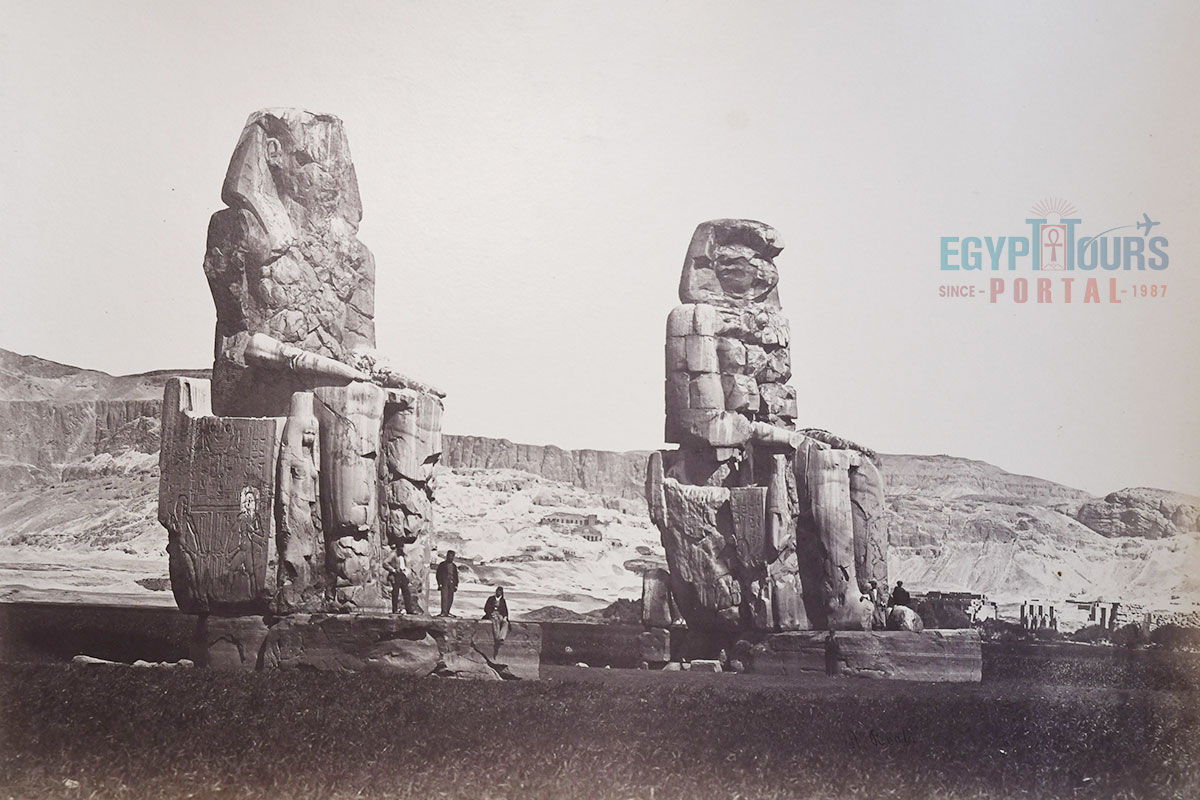
The mortuary complex of Amenhotep III was the largest temple complex of its time, surpassing even the vast Temple of Karnak in grandeur. Spanning over 86 acres (35 hectares), the complex included multiple rooms, courts, halls, and colonnades that symbolized the Egyptian concept of the afterlife, or Field of Reeds.
This complex was built to serve as a place of worship for the deified king, where he would be venerated both in life and death. The grand layout was designed to convey Amenhotep’s connection to one of the most famous ancient Egyptian gods, Osiris, god of the afterlife, and to reinforce his role as a god-king who would be reborn for eternity. The complex featured numerous colossal statues, open courtyards, and colossal columns that mirrored the paradisiacal vision of the afterlife held by the ancient Egyptians.
While much of this temple complex has disappeared due to natural disasters, including Nile floods and earthquakes, the Colossi of Memnon have managed to withstand these forces. The figures of Amenhotep III, along with the smaller carvings of his mother and wife, serve as symbols of rebirth and regeneration, ideas central to Egyptian religious beliefs. Standing at the entrance, the Colossi were intended not only as guardians but also as conduits through which the king’s spirit could receive sustenance and strength from the realm of the living.

One of the most fascinating aspects of the Colossi of Memnon is the mysterious "singing" or "vocal" phenomenon associated with the northern statue. After it was cracked in an earthquake in 27 BCE, the damaged statue reportedly emitted sounds at dawn, often described as a whistling, humming, or even musical tone.
Ancient sources such as Strabo, Pausanias, and Pliny the Elder recorded their experiences with the phenomenon, which became popular among travelers seeking oracular prophecies. Historians believe the sounds were likely caused by dew evaporating from cracks in the stone as the morning sun warmed the statue.
The phenomenon ceased entirely after repairs by Emperor Septimius Severus in 199 CE, when the cracks were sealed, but the legend of the "Vocal Memnon" has lived on, adding a layer of mystery to these already awe-inspiring statues.

The Colossi of Memnon are important for several reasons. They serve as monumental guardians of the once-magnificent mortuary temple of Amenhotep III, one of ancient Egypt’s most powerful pharaohs. As rare surviving artifacts from his reign, the statues provide valuable insight into ancient Egyptian art, religious beliefs, and mortuary practices during the New Kingdom.
The Colossi also hold historical significance due to their connection with the Greek legend of Memnon, bridging Egyptian history with Greek mythology. Furthermore, the mysterious "singing" sound that once emanated from the statues drew ancient travelers and scholars, turning the site into a center of early tourism and divination.
Today, they stand as enduring symbols of Egypt's cultural heritage, drawing visitors from around the world who come to witness their grandeur and learn about their fascinating history.
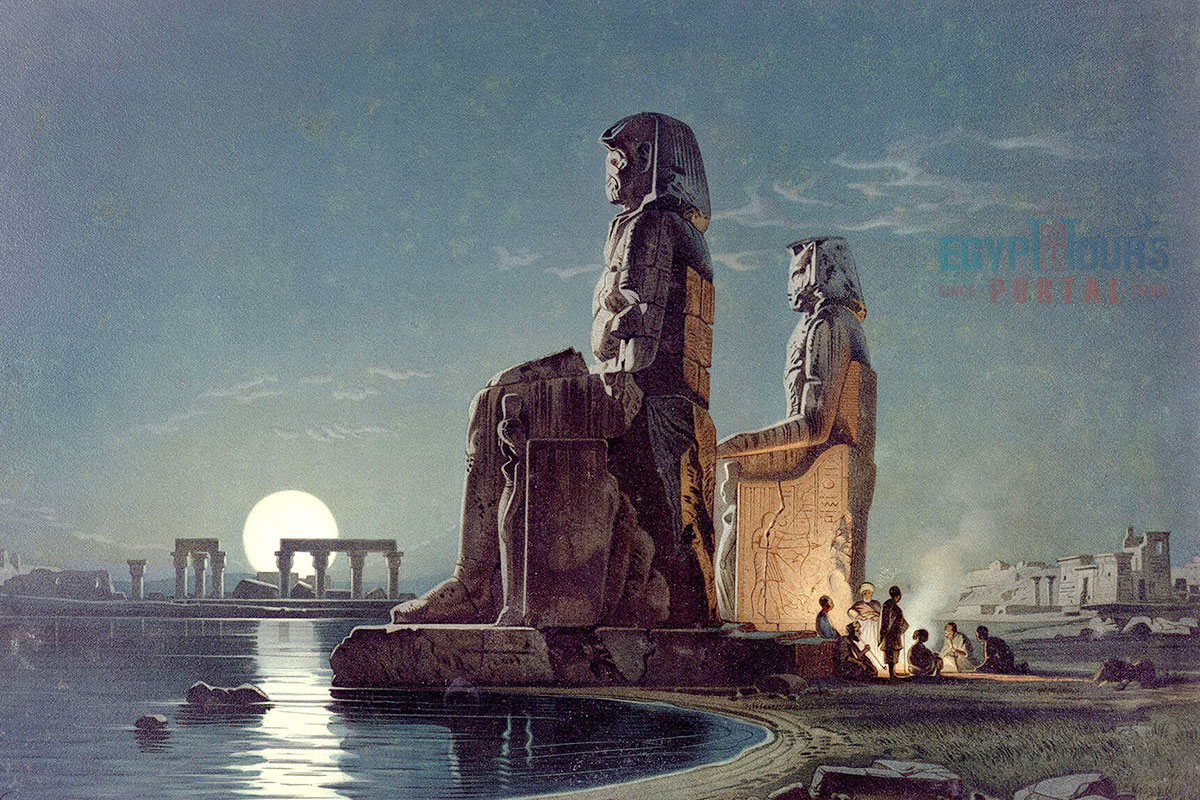
Today, visitors to the Colossi of Memnon can view the statues’ remaining details, from the seated representation of Amenhotep III to the smaller figures of his wife, Queen Tiye, and his mother, Mutemwiya. The statues still bear some traces of the intricate carvings and reliefs depicting Hapy and other symbolic figures that signify life, prosperity, and divine protection.
Despite their damaged condition, the Colossi remain a powerful testament to the skill and artistry of ancient Egyptian sculptors and the grandeur of the Egyptian empire. As tourists stand before these statues, they witness not only the scale of the structures but also the enduring legacy of a civilization that held such power over its people and the ancient world.

The Colossi of Memnon, which date back to approximately 1350 BCE, have undergone various restoration efforts throughout history. Over the centuries, these statues have endured significant damage, particularly from natural events like floods and earthquakes. In 27 BCE, an earthquake left the northern statue severely damaged, cracking it from the waist up, while the southern statue remained largely intact.
Recognizing their historical and cultural value, the Roman Emperor Septimius Severus ordered repairs in the 2nd century CE, especially to the northern colossus. Restoration efforts continue today, with modern archaeologists focusing on conservation and preservation.
In recent decades, teams led by experts like Hourig Sourouzian have excavated and restored parts of the original mortuary complex around the statues, helping to reconstruct the layout of Amenhotep III’s grand temple and ensuring that the Colossi can be appreciated by future generations.
While being in Luxor, Everyone will have to visit the remarkable Colossi of Memnon to be able to see the greatness of the Ancient Egyptians through our Egypt tours or Nile river cruise presented by “Egypt Tours Portal”. Everyone will come to cast their eyes on some of the greatest archaeological attractions ever built in the history of the world.
Day Trip from Luxor to Cairo by Plane For Canadian Travelers Day trip from Luxor to ...
Tour Location: Cairo...
Tour to Luxor West Bank For Canadian Travelers Tour to Luxor West Bank is like stepp...
Tour Location: Luxor...
Tour to Edfu and Kom Ombo For Canadian Travelers Edfu & Kom Ombo Tour from Luxo...
Tour Location: Edfu/Kom Ombo...
Trip to Dandara and Abydos from Luxor for Canadian Travelers A Trip to Dandara and A...
Tour Location: Dandara/Abydos...
The Colossi of Memnon represent Pharaoh Amenhotep III as a deified ruler and eternal protector of his mortuary temple. The statues were intended to convey his power and godly status and were strategically placed to guard the entrance of the complex.
Their eastern orientation, facing the rising sun, symbolized rebirth and the continuation of the king's legacy. The smaller figures of Amenhotep’s mother, Mutemwiya, and wife, Tiye, along with carvings of the Nile god Hapy, emphasize themes of family, fertility, and rebirth.
Over the centuries, the Colossi of Memnon were damaged by a series of natural disasters, including earthquakes and floods. The most notable earthquake occurred in 27 BCE, which fractured the northern statue from the waist up and led to the "singing" phenomenon that made the statues famous.
Much of the original mortuary complex surrounding the Colossi was lost due to erosion and the reuse of stone blocks in later constructions. Despite these losses, the statues themselves remain relatively intact and are now preserved as historical monuments.
The Colossi of Memnon are unique for several reasons. They are among the few surviving artifacts of the immense mortuary complex built by Amenhotep III. Their size and structure, each hewn from a single block of quartzite sandstone, exemplify the engineering prowess of ancient Egyptian builders.
The statues’ connection to the Greek legend of Memnon adds a fascinating cross-cultural dimension, bridging Egyptian and Greek traditions. Additionally, the mysterious sounds produced by the northern statue after it was damaged sparked curiosity among ancient visitors and continue to intrigue historians and tourists alike.
The Colossi contain over 100 inscriptions in Greek and Latin, left primarily by Roman travelers and officials who visited the site between the 1st and 3rd centuries CE.
Many of these inscriptions were carved by those who claimed to have heard the statue’s sounds, recording their experience and sometimes making note of their names, titles, and origins. These ancient inscriptions provide a glimpse into early tourism, as well as the site’s renown as a place of pilgrimage for those seeking divine insight or blessings from the "Vocal Memnon."
The entire country of Egypt deserve to be explored with its every heavenly detail but there are places that must be seen before any other such as the breathtaking Hurghada's red sea, The wonders of Cairo the pyramids of Giza, the great sphinx, the Egyptian Museum, Khan El Khalili Bazaar, the wonders of Luxor like Valley of the Kings, Karnak & Hatshepsut temple and the wonders of Aswan such as Abu Simbel temples, Philea temple, Unfinished obelisk and The Wonders of Alexandria like Qaitbat Citadel, Pompey's Pillar and Alexandria Library. Read more about the best places to visit in Egypt.
If you want to apply for a Visa On Arrival that lasts for 30 days then you should be one of the eligible countries, have a valid passport with at least 6 months remaining and pay 25$ USD in cash, as for the E-Visa for 30 day you should have a valid passport for at least 8 months, complete the online application, pay the e-visa fee then print the e-visa to later be presented to the airport border guard. You could also be one of the lucky ones who can obtain a free visa for 90 days. Read more about Egypt travel visa.
Egypt has a variety of delicious cuisines but we recommend “Ful & Ta’meya (Fava Beans and Falafel)”, Mulukhiya, “Koshary”, a traditional Egyptian pasta dish, and Kebab & Kofta, the Egyptian traditional meat dish.
The best time to travel to Egypt is during the winter from September to April as the climate becomes a little tropical accompanied by a magical atmosphere of warm weather with a winter breeze. You will be notified in the week of your trip if the Climate is unsafe and if any changes have been made.
You should pack everything you could ever need in a small bag so you could move easily between your destinations.
We have been creating the finest vacations for more than 20 years around the most majestic destinations in Egypt. Our staff consists of the best operators, guides and drivers who dedicate all of their time & effort to make you have the perfect vacation. All of our tours are customized by Travel, Financial & Time consultants to fit your every possible need during your vacation. It doesn't go without saying that your safety and comfort are our main priority and all of our resources will be directed to provide the finest atmosphere until you return home.
You will feel safe in Egypt as the current atmosphere of the country is quite peaceful after the government took powerful measures like restructuring the entire tourist police to include all the important and tourist attractions in Egypt. Read more about is it safe to travel to Egypt.
Wear whatever feels right and comfortable. It is advised to wear something light and comfortable footwear like a closed-toe shoe to sustain the terrain of Egypt. Put on sun block during your time in Egypt in the summer to protect yourself from the sun.
The best activity is by far boarding a Nile Cruise between Luxor and Aswan or Vise Versa. Witness the beauty of Egypt from a hot balloon or a plane and try all the delicious Egyptian cuisines and drinks plus shopping in old Cairo. Explore the allure and wonders of the red sea in the magical city resorts of Egypt like Hurghada and many more by diving and snorkeling in the marine life or Hurghada. Behold the mesmerizing western desert by a safari trip under the heavenly Egyptian skies.
There are a lot of public holidays in Egypt too many to count either religious or nation, the most important festivals are the holy month of Ramadan which ends with Eid Al Fitr, Christmas and new years eve. Read more about festivals & publich holidays in Egypt.
Egypt is considered to be one of the most liberal Islamic countries but it has become a little bit conservative in the last couple of decades so it is advised to avoid showing your chest, shoulders or legs below the knees.
Arabic is the official language and Most Egyptians, who live in the cities, speak or understand English or at least some English words or phrases. Fewer Egyptians can speak French, Italian, Spanish, and German. Professional tour guides, who work in the tourism sector, are equipped to handle visitors who cannot speak Arabic and they will speak enough English and other languages to fulfill the needs of all our clients.
The fastest way is a car, of course, a taxi. If you are in Cairo ride a white taxi to move faster or you could board the fastest way of transportation in Egypt metro if the roads are in rush hour.
The temperature in Egypt ranges from 37c to 14 c. Summer in Egypt is somehow hot but sometimes it becomes cold at night and winter is cool and mild. The average of low temperatures vary from 9.5 °C in the wintertime to 23 °C in the summertime and the average high temperatures vary from 17 °C in the wintertime to 32 °C in the summertime. The temperature is moderate all along the coasts.
It is the home of everything a traveler might be looking for from amazing historical sites dating to more than 4000 years to enchanting city resorts & beaches. You will live the vacation you deserve as Egypt has everything you could possibly imagine.









